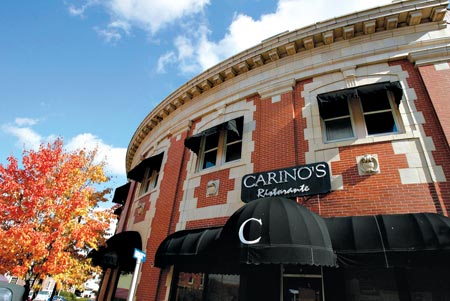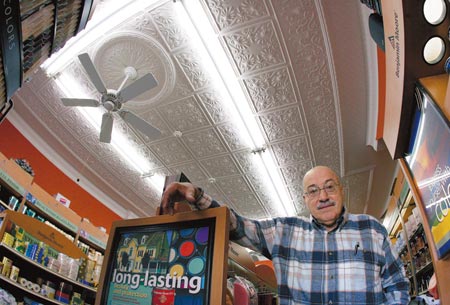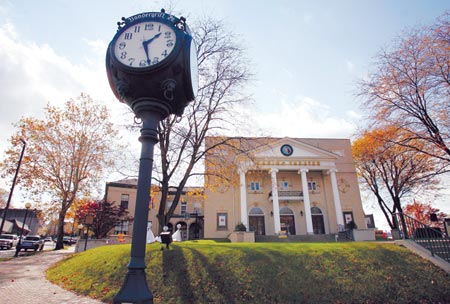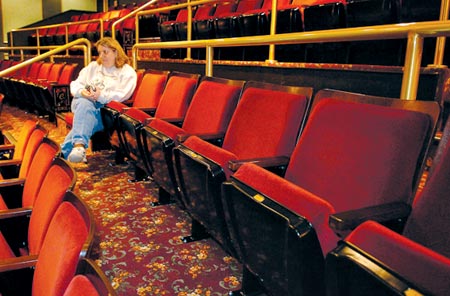
Historic Vandergrift looks to future
By Marjorie Wertz
FOR THE TRIBUNE-REVIEW
Sunday, November 19, 2006
In 1901, six years after the establishment of Vandergrift, Westmoreland County, Steel Workers Magazine called the town a “working man’s paradise.”
Designed by Frederick Law Olmstead, the architect of New York’s Central Park and the grounds of the U.S. Capitol in Washington, D.C., Vandergrift was a planned community founded by George G. McMurtry, president of the Apollo Iron and Steel Co., Apollo. It was named after Captain J.J. Vandergrift, a director of the steel mill.
“McMurtry was one of the first industrialists who gave respect to the working man,” said Ken Blose, a member of the Victorian Vandergrift Museum and Historical Society. “He believed that educated, churchgoing men who owned their own homes in their own community would make the best workers. These were radical thoughts at that time.”
McMurtry needed to expand his galvanized steel mill, so he bought a 650-acre farm site several miles downstream on the Kiskiminetas River. Olmstead designed the town so that the streets followed the natural slope of the hills and the curve of the river. The mill was constructed; streets were graded; utilities were installed; trees were planted; and street lights were erected.
“There were 14 main streets in the original design and only one place where two streets crossed,” Blose said. “There are no real corners. Every corner is a sweeping curve.”
Once the town was laid out, lots were sold only to men who worked in the mill. McMurtry established a bank so mill workers could buy homes at rates they could afford.
“For a man working in a mill in 1895, the opportunity to purchase his own home was practically nil,” Blose said.
McMurtry continued his philanthropic actions through the purchase of pipe organs for all the town’s churches. He also donated land for schools and the fire department and bought the fire department’s first equipment. Blose said McMurtry also sold land for $1 to the town for a cemetery.
“And what land that was undeveloped, he allowed the townspeople to use for recreational purposes,” Blose said.
At the 1904 World’s Fair in St. Louis, Vandergrift won two gold medals for best town design, and, in 1907, the Vandergrift steel mill was the largest rolling mill in the world, producing high-quality silicon steel.
“The steel for the centerpiece of the 1964 New York World’s Fair; the Unisphere, the largest metal sculpture in the world, was finished and polished in Vandergrift. Some of the steel for the St. Louis Arch was produced in Vandergrift, and the hinges for the gates and other parts of the Panama Canal were produced in the Vandergrift Foundry,” Blose said.
McMurtry also was the primary contributor to the construction of the town’s municipal building, which housed the jail, administration offices and a 500-seat theater. That building, the Casino Theatre, is undergoing renovations by a group of volunteers, Casino Theatre Restoration and Management.
“The theatre was being used by the borough for storage,” said Mary Lee Kessler, treasurer of the organization. “The theatre seats, stage curtain and all the decorative items within the theatre had been removed. There were rumors that the theatre was going to be torn down. We couldn’t let that happen.”
Built in 1900 in the Greek revival style, the theatre was a popular venue on the vaudeville circuit. President William H. Taft, boxing champ Bob Fitzsimmons, composer Hoagy Carmichael, Tex Ritter and the Three Stooges visited the Casino.
The Casino was remodeled in 1927 as the area’s largest movie theater, and in the ’50s, it was converted to show wide-screen movies. It closed in 1981.
“The east wing of the building still houses the library, and the west wing has the offices of the borough secretary, the jail and police station,” Kessler said. “The theatre was in great disrepair, but the borough was very open to a responsible group attempting to revive it, so they leased it to us for $1 a year with the understanding that we would apply for grants to renovate it.”
Kessler has been successful in obtaining grants for renovation projects. The organization was able to locate 475 seats for $5,000 and install electrical wiring, lighting and sound. A group of volunteers, affectionately called the Tuesday Night Work Crew, arrive at the theatre Tuesday evenings and “do what needs to be done,” Kessler said.
“We replaced the four wooden ionic columns in the front of the theatre, excavated in the basement, and now there’s a very pretty ladies lounge there. We also reopened the mezzanine level and renovated the front lawn,” she said.
The discovery of two old movie window cards netted the organization about $37,000, which was used to repair the theatre’s roof. A group of Eagle Scouts was cleaning out a portion of the theatre’s upper floor when it located an old desk with an ink blotter. Under the blotter, the group found a perfectly preserved window card for the 1927 science fiction movie “Metropolis,” directed by Fritz Lang.
“One of the volunteers contacted a fellow from Greensburg who was extremely excited because memorabilia from that move is very collectible,” Kessler said. “That window card was auctioned off by Sotheby’s, and we netted $24,000.”
A second window card for the movie that had a small bend in one corner was auctioned several years later and sold for about $13,000.
The Casino Theatre officially reopened its doors in August 1995. Three years ago, Mickey Rooney performed there, and in April, trumpeter Maynard Ferguson gave one of his last performances before dying Aug. 23.
“Every year we do a magic show for children at the end of October, and during the first weekend of December, we self-produce ‘Hometown Christmas.’ This year, it will be a musical revue,” Kessler said.
On Nov. 25, 14 bands will put on a benefit concert at the Casino to help the organization pay the heating bill.
“This is a fun place to be. The people who volunteer here are very enthusiastic,” Kessler added.
The Vandergrift Improvement Program — VIP — is another nonprofit organization comprising local residents, businesses, municipal and state government officials working to protect, preserve and restore the community through the National Trust for Historical Preservations’ Main Street approach.
“We had 15 vacant storefronts out of 100 stores in our town. We didn’t want the town to rot away,” said Wayne Teeple, vice president of the 100-member VIP.
The premise of the town’s Main Street approach is to encourage economic revitalization through a four-pronged system — design, economic restructuring, promotion and organization — to address all of the commercial district’s needs.
The town, which is listed on the National Register of Historic Places, is in the first year of the Main Street program.
“We had to raise $94,000 to obtain funding for a Department of Community and Economic Development Main Street grant,” Teeple said. “Within a three-month period, the residents and Vandergrift government pledged that amount over a five-year period.”
The Pittsburgh History and Landmarks Foundation, a nonprofit historic preservation group, was hired to manage the Main Street program, said Eugene Matta, director of the foundation’s real estate and special-development programs.
Shaun Yurcaba, of History and Landmarks, is Vandergrift’s Main Street coordinator. She is helping VIP coordinate its efforts.
“The four committees working in design, economic restructuring, promotion and organization fulfill the requirements of the Main Street program,” Yurcaba said.
The design committee is developing guidelines for the protection of historical buildings during changes or renovations. Those on the economic restructuring committee are determining how many businesses are downtown and what types of businesses are in place in order to gauge what improvements are needed.
“The organization committee works on establishing relationships with other community organizations such as the Casino Theatre renovation group and the historical society,” Yurcaba added.
Trying to bring people into town is the work of the promotion committee, which sponsors events such as a summer car cruise and a 2007 pet calendar contest, in which people cast ballots for their favorite pet photos at Vandergrift businesses.
“Once we go into year two of the Main Street project, we become eligible for an $80,000 grant — $30,000 of it will be available to downtown building owners in the form of grants,” Teeple said. “They can apply for a $5,000 matching grant for renovating the facades of their buildings. We already have five building owners interested in this.”
Other groups are working toward Vandergrift’s revitalization, as well.
“Sustainable Pittsburgh is working with us so that Vandergrift becomes a green sustainable development,” Matta said. “And the Mascaro Sustainability Initiative through the University of Pittsburgh’s School of Engineering is also working on quite a project in Vandergrift.”
Sustainable Pittsburgh served as the “matchmaker” between the initiative and Vandergrift, said Eric Beckman, co-director of the Mascaro Sustainability Initiative.
“The goal of MSI is to create the next generation of technology that is cost-effective and sustainable,” Beckman said. “We brought in a team of undergraduate engineering students into Vandergrift and asked them if they could bring energy conservation to the Casino Theatre. The question became ‘How do you lower energy bills without destroying the historic value of the community?’ ”
The shallow, yet swift-flowing Kiski River, which surrounds Vandergrift on three sides, might be able answer, Beckman said. The group submitted a proposal to the National Collegiate Inventors and Innovators Alliance for a sustainable creative energy grant.
“We went in on this proposal with Sustainable Pittsburgh. Whatever we come up with in Vandergrift, we could use in other parts of the state,” Beckman said. “Eventually, we want to create something that will generate electricity and try it out in Vandergrift. The town will be our test bed.”
All the partnerships have helped VIP pick up steam on revitalization projects.
“Other towns are calling us for information. Everyone has a passion for this, and it’s something that’s really taking off,” Teeple said.
- Carino’s, which closed several years ago, was housed in one of Vandergrift’s signature buildings. — Bob Fritz/For the Tribune-Review
- John Pomfret repainted a turn-of-the-century tin ceiling in his store, Pomfret’s Paint and Variety. — Bob Fritz/For the Tribune-Review
- The Casino Theatre was remodeled in 1927 and again in the ’50s before closing in 1981. It reopened in August 1995 after undergoing extensive work. The building houses a library, municipal offices and a police station. — Bob Fritz/For the Tribune-Review
- Mary Lee Kessler is treasurer of Casino Theatre Restoration and Management, a group of volunteers renovating the theater. — Steven Dietz/For the Tribune-Review
Marjorie Wertz can be reached at .




